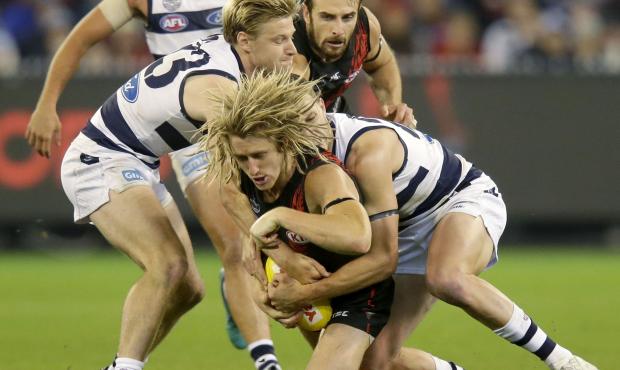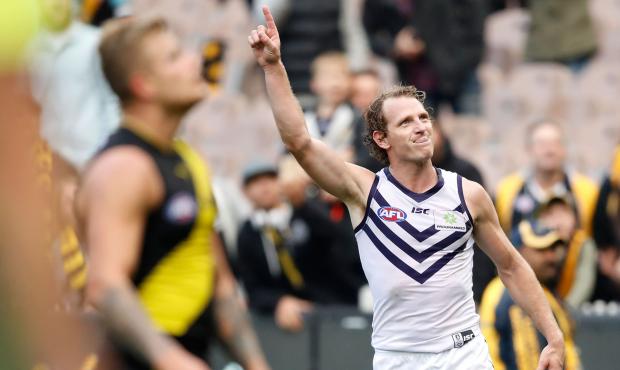
Why the Cats are losing their claws
GEELONG couldn't tackle a problem right now.
But the Cats need to, and quickly.
In the first half against Essendon on Saturday night, they took bananas to a gunfight, laying just 14 tackles to be dead and buried at the long break.
• Five talking points: Cats sink to 11-year low v Essendon
They weren't the lowest first-half tackling numbers the Cats have recorded for the season either.
The Cats laid just 13 tackles in the first half against North Melbourne in round two.
The last rites were being read at half-time in that game before the Cats made a Lazarus-like comeback to defeat the Kangaroos by a point.
In the past three rounds, however, the comebacks have fallen short, with the Cats losing and conceding more than 100 points for the first time in three successive weeks since rounds 8-10, 2006.
And they're slipping down the ladder as a result, struggling to get a grip on each rung to cushion their fall.
The effect that such poor pressure has is enormous, as it allows the opposition to slip out the front of stoppages and makes it hard for defenders in aggressive positions.
In an instant the system can look worse than it is, as the backline looks like it's doing a mannequin challenge rather than trying to intercept the ball.
That's why Cats coach Chris Scott must look at some individuals to turn things around.
Mark Blicavs is one in the firing line.
He didn't record a tackle against Essendon, the second time this year he has left a duck egg in the tackles column.
Blicavs is spending less time around stoppages with the third-man up banned, but he was top 15 in the AFL for tackle numbers in the past two seasons, laying at least one tackle a game.
This season he averages 2.8 tackles per game, down from six in 2016.
Even skipper Joel Selwood has dropped off in that part of the game in the past three rounds, down from an unsustainably high 8.2 tackles per game up until round five to just 3.3 per game in the past three rounds.
Rather than a lack of effort, the fall-away is more likely due to a breakdown in the mechanics around stoppages that allowed pressure to be applied.
That breakdown led to Essendon kicking four goals from stoppages in the first quarter, skipping away from the congestion to outrun Geelong in a manner that has become too regular in the past three weeks.
The Cats land a rare tackle against Essendon on Saturday. Picture: AFL Photos
The Cats are being slaughtered on the spread, having gone from +5 in the uncontested differential in the first five rounds to -46 (the second worst in the AFL) from rounds six to eight.
The opposition is running through the corridor in the same manner as it did in the first five rounds (33 per cent of the time), but they are able to do so with less pressure being applied.
As a result, the opposition has averaged 15 marks a game inside 50 since round six against Geelong, the fourth worst result in that time in the AFL, and throughout the season it has conceded way too many uncontested marks to be -22.7 on the differential since round six.
The Cats are giving their opposition way too much time and space, not defending high enough up the ground to force turnovers in the attacking half of the ground.
And when they do get the ball and their opponents block the corridor they have too often stopped attacking, instead kicking backwards and sideways in search of the perfect entry.
If they are going to turn things around on Friday night against the Western Bulldogs, tackles must stick and the source must be plugged.
Rory Sloane is officially the Adelaide barometer
If teams quieten him down, the party stops raging.
The Crows' loss to West Coast in round 23 last season when Sloane was suspended highlighted his importance.
North Melbourne reminded everyone of that fact in round seven when Sam Gibson was sent to him and turned the music off. Now it seems the neighbours have caught on.
Stop the troublemaking Sloane and the rest of the Crow midfielders will not cause any problems.
One year apart, two very different outcomes for the Tigers
Exactly 12 months passed between Richmond forward Sam Lloyd's post-siren winning goal against the Sydney Swans on May 14, 2016, and David Mundy's winning goal after the bell on Sunday.
It was the third time in Damien Hardwick's coaching career he has watched a goal after the siren decide a Tigers' game … Karmichael Hunt anyone?
Why they don't like Mundys

Fremantle has won four games in its short history with goals after the siren, with Mundy now adding his name alongside Quinton Leach, Jeff Farmer and Justin Longmuir as Dockers' post-siren heroes.
Mundy was a good man to get the ball to, as he is a dead-eye in the final term when it comes to set shots.
Mundy is more reliable than the champ who succeeded him as skipper since both went into battle together in the 2013 decider
| Games | Goals | Scores from set shots | Q1 | Q2 | Q3 | Q4 | |
|---|---|---|---|---|---|---|---|
| David Mundy | 73 | 35 | 18.7 | 6.3 | 4.0 | 1.2 | 7.2 |
| Nat Fyfe | 53 | 56 | 27.13 | 6.2 | 9.3 | 10.5 | 2.3 |
We are living in tight times
Sunday's last-second win by Freo was the 11th game this season decided by five points or fewer.
That is the biggest number of close games in the first eight rounds since the Gold Coast entered the competition in 2010.
The Dockers had time to spare
It took 12 seconds for Fremantle to win the ball from the centre bounce and get it into Mundy's hands. Dockers coach Ross Lyon joked to Fox Footy that he was in a pub in Fitzroy on his second pot by that time.
There were 23 goals kicked from centre bounces in round eight.
In 15 of them, the goalkicker had possession within 20 seconds of the centre bounce.
The fastest? Hawthorn's Ricky Henderson had the ball in his hands seven seconds after a centre bounce against the Lions before kicking a last-quarter goal.
Want more?
• Read more from the Stats Files
• Who starred for your club in this weekend's state leagues?



